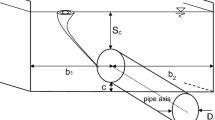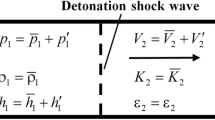Abstract
During earlier research on shock wave/boundary layer interaction control, the effect of air humidity on flow separation has been observed. This has inspired a more detailed study on the effect of air humidity on shock induced incipient separation and on the involved processes. The phenomenon has a twofold nature. In supersonic flow, the condensation of humidity causes flow retardation due to heat addition. The consequent weakening of the shock wave reduces the tendency towards separation. On the other hand, the incipient separation is postponed at the same Mach numbers of interaction.
Similar content being viewed by others
References
Bur, R., Corbel, B. and Delery, J., “Study of passive control in a transonic shock wave/boundary layer interaction,” AIAA Journal,36, No.3, pp.394–400, (1998).
Bohning, R., Doerffer, P., “Passive control of shockwave-boundary layer interaction and porous plate transpiration flow, Notes on Numerical Fluid Mechanics,” Volume 56, ISSN 0179-9614, ISBN 3-528-07656-9,(1993–1995).
Schnerr, G., “Homogene Kondensation in Stationaeren transsonischen Stroemungen durch Lavalduesen und um Profile,” Habilitationsschrift 1986, University of Karlsruhe, Mechanical Engineering Faculty.
Author information
Authors and Affiliations
Rights and permissions
About this article
Cite this article
Doerffer, P., Szumowski, A. & Yu, S. The effect of air humidity on shock wave induced incipient separation. J. of Therm. Sci. 9, 45–50 (2000). https://doi.org/10.1007/s11630-000-0044-8
Issue Date:
DOI: https://doi.org/10.1007/s11630-000-0044-8




